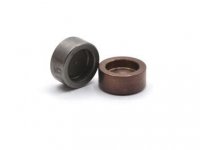TGTool
Titanium
- Joined
- Sep 22, 2006
- Location
- Stillwater, Oklahoma
Anyone with actual experience in this realm may be a long shot but I'm sure there will be opinions too.
I need some adjustment shims for a 1980's Maserati 6 cyl which are the little caps on the valve stem similar to Alfa but not identical so plan to make some.
Machining itself isn't a particular challenge but I'm wondering about material. I had one tested at my heat treater and it came out barely 50 Rc, which surprised me at first. Then I recalled hearing that one Maserati race failure was from cracked valve shims so I see their point. I'd planned on using O-1 as readily available in 10mm stock and drawing them back to 50 Rc or thereabouts.
Recently it occurred to me to wonder if S7 had any advantage. In service the shims see compression but it's over the end of the valve stem and the cam follower so not a concentrated hit as in chisels, for example. All told it just "feels" to me that O-1 drawn back to only moderately hard ought to be plenty good enough but I'll solicit experience or alternate opinions.
I need some adjustment shims for a 1980's Maserati 6 cyl which are the little caps on the valve stem similar to Alfa but not identical so plan to make some.
Machining itself isn't a particular challenge but I'm wondering about material. I had one tested at my heat treater and it came out barely 50 Rc, which surprised me at first. Then I recalled hearing that one Maserati race failure was from cracked valve shims so I see their point. I'd planned on using O-1 as readily available in 10mm stock and drawing them back to 50 Rc or thereabouts.
Recently it occurred to me to wonder if S7 had any advantage. In service the shims see compression but it's over the end of the valve stem and the cam follower so not a concentrated hit as in chisels, for example. All told it just "feels" to me that O-1 drawn back to only moderately hard ought to be plenty good enough but I'll solicit experience or alternate opinions.



